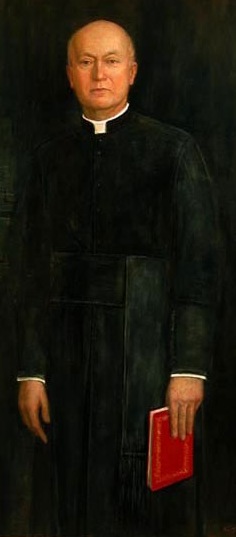
FROM THE PASTOR
By Fr. George W. Rutler
September 28, 2008
To bury the dead is one of the seven corporal works of mercy. The human body is to be treated with respect from conception through death. In the general resurrection of the dead, the body will be glorified in a mysterious way in union with the soul. The Church regulates the treatment of the dead (Catechism #2000). Burial of the body is normative, but cremation is permitted, provided that it does not signal disbelief in the resurrection of the body. In a large city, with cemeteries often far removed, it is still desirable that the body of the deceased be brought to the church for the funeral Mass before burial or cremation. Only by exception is a body to be cremated before the funeral and the ashes brought to the Mass. I am occasionally surprised when people are uninformed about these things and make funeral arrangements before c onsulting a priest.
A Manichean concept of the body virtually worships it as an idol in life and then treats it as irrelevant after it has lost its earthly usefulness. Contempt for God leads to contempt for the human body. At the South Street Seaport, there currently is a display of 22 whole bodies and more than 260 additional organs and partial body specimens. "Bodies—The Exhibition" is a version of "Body Worlds," which in recent years has exploited prurience in the name of scientific edification. The corpses are skinned, and the blood replaced with silicon polymers. These plasticized bodies are shown in various poses, sometimes whimsically. Dr. Thomas Hibbs, professor of ethics and culture at Baylor University, has called it pornographic.
The founder of "Body Worlds" is Gunther von Hagens, who invented the "Plastination" method at the University of Heidelberg. He is not culpable for his father having served in the Nazi SS in a perverse age when lampshades were made of human skin. That horrified people then. A generation later, more than 20 million people around the world have paid to view "plastinated corpses" for the thrill of it. Von Hagens moved to China in 1996 where bodies were more easily obtainable, some of them rumored to be the bodies of homeless or mentally ill people or executed prisoners. In 2004, bullet holes were found in two of the exhibited "sculptures." The anonymous bodies on display in Manhattan were taken from the Dalian Medical University in northern China. The New York State legislature this summer passed a bill requiring a declaration of the cause of death of the exhibited remains. Is it possible that if you visited this exhibition, you were looking at a Christian martyr
By Fr. George W. Rutler
September 28, 2008
To bury the dead is one of the seven corporal works of mercy. The human body is to be treated with respect from conception through death. In the general resurrection of the dead, the body will be glorified in a mysterious way in union with the soul. The Church regulates the treatment of the dead (Catechism #2000). Burial of the body is normative, but cremation is permitted, provided that it does not signal disbelief in the resurrection of the body. In a large city, with cemeteries often far removed, it is still desirable that the body of the deceased be brought to the church for the funeral Mass before burial or cremation. Only by exception is a body to be cremated before the funeral and the ashes brought to the Mass. I am occasionally surprised when people are uninformed about these things and make funeral arrangements before c onsulting a priest.
A Manichean concept of the body virtually worships it as an idol in life and then treats it as irrelevant after it has lost its earthly usefulness. Contempt for God leads to contempt for the human body. At the South Street Seaport, there currently is a display of 22 whole bodies and more than 260 additional organs and partial body specimens. "Bodies—The Exhibition" is a version of "Body Worlds," which in recent years has exploited prurience in the name of scientific edification. The corpses are skinned, and the blood replaced with silicon polymers. These plasticized bodies are shown in various poses, sometimes whimsically. Dr. Thomas Hibbs, professor of ethics and culture at Baylor University, has called it pornographic.
The founder of "Body Worlds" is Gunther von Hagens, who invented the "Plastination" method at the University of Heidelberg. He is not culpable for his father having served in the Nazi SS in a perverse age when lampshades were made of human skin. That horrified people then. A generation later, more than 20 million people around the world have paid to view "plastinated corpses" for the thrill of it. Von Hagens moved to China in 1996 where bodies were more easily obtainable, some of them rumored to be the bodies of homeless or mentally ill people or executed prisoners. In 2004, bullet holes were found in two of the exhibited "sculptures." The anonymous bodies on display in Manhattan were taken from the Dalian Medical University in northern China. The New York State legislature this summer passed a bill requiring a declaration of the cause of death of the exhibited remains. Is it possible that if you visited this exhibition, you were looking at a Christian martyr
Subscribe to:
Post Comments (Atom)


No comments:
Post a Comment